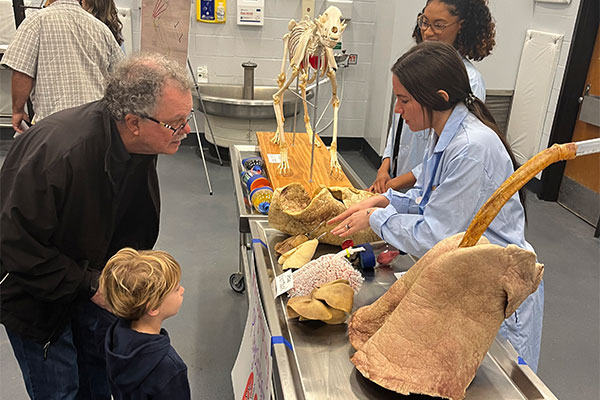Katrina at 20
20 heroic tales of people helping animals
as told to Sandra Sarr, LSU Vet Med strategic communications
Michelle L. Osborn, MA, PhD, LSU Vet Med Associate Professor

Visitors learn about anatomy in the LSU Vet Med anatomy lab.
– Photo Credit: Ginger Guttner
“In August 2005 I was a graduate student at LSU taking comparative vertebrate anatomy when Hurricane Katrina hit early in the semester. The LSU campus opened up to receive displaced New Orleanians. Everyone wanted to help. I volunteered for a Find Family Call Center in Baton Rouge and invited friends and family to stay with me. It became increasingly clear that Louisiana, New Orleans in particular, had been fundamentally changed by a natural disaster of epic proportions. You can see the very best of people when times are most dire. As a student on the LSU campus, I watched as the classrooms of LSU, while not physically changing in size, were suddenly large enough to hold students from universities in New Orleans. The continuation of classes seemed unimportant, but it also created a routine, a distraction, perhaps some sense of normalcy during a time that was anything but normal.
There is no better example of this than what happened in the Veterinary Anatomy Laboratory at LSU Vet Med. Professor Emeritus Daniel J. Hillmann, opened the veterinary anatomy lab to the LSUHSC human anatomy cadaver labs, headed by Professor Emeritus William J. Swartz, so that the impact of Katrina on the training of LSU medical students could be minimized as much as possible. Anyone who has met Dr. Hillmann, or any of the people who were working with him at the time, is not surprised that they did not hesitate to make the lab available to their fellow anatomists in a time of need. This simple action had lasting impacts. Human anatomists in the LSU Kinesiology Department ensured that the cadaver courses could continue for the medical students and introduced their own undergraduate students to human cadavers, a unique opportunity that has made LSU’s Kinesiology students top notch and highly competitive in getting into medical schools. The veterinary anatomy lab continued to house the LSU Kinesiology cadaver courses, headed by Drs. Dennis Landin, Wanda Hargroder, and Melissa Thompson, until their state-of-the-art Rathbone Human Anatomy & Cadaver Lab was completed in 2023. My own master’s and then PhD research into the head, neck, and shoulders of humans flourished because of the presence of the human anatomists, their students, and materials at the vet school.”